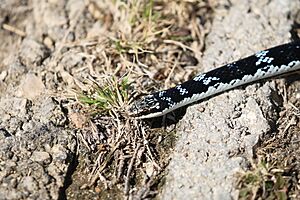Caraiba facts for kids
Caraiba is a special group of snakes that only has one species: Caraiba andreae. This snake is also known as the black and white racer or the Cuban lesser racer. It lives only in Cuba. There are six different types, or subspecies, of this snake.
Quick facts for kids Caraiba |
|
|---|---|
 |
|
| C. andreae morenoi | |
| Conservation status | |
| Scientific classification | |
| Genus: |
Caraiba
|
| Species: |
andreae
|
| Synonyms | |
|
List
|
|
Contents
Discovering the Cuban Lesser Racer
The name of the snake group, Caraiba, comes from the Caribbean Sea. This is where the snake lives. The second part of its scientific name, andreae, honors a Danish ship captain. His name was "Captain Andrea". He was the one who found the very first snake of this type. This first snake is called the holotype.
Different Kinds of Cuban Racers
Scientists recognize six different types of the Cuban lesser racer. These are called subspecies. Each subspecies has a slightly different look or lives in a specific area.
- Caraiba andreae andreae (Reinhardt & Lütken, 1862)
- Caraiba andreae melopyrrha (Thomas & Garrido, 1967)
- Caraiba andreae morenoi (Garrido, 1973)
- Caraiba andreae nebulatus (Barbour, 1916)
- Caraiba andreae orientalis (Barbour & Ramsden, 1919)
- Caraiba andreae peninsulae (Schwartz & Thomas, 1960)
When you see a name like (Reinhardt & Lütken, 1862) in parentheses, it means these scientists first described the subspecies. They might have placed it in a different snake group at that time.
Where the Cuban Racer Lives
The Cuban lesser racer, also known as C. andreae, lives all over Cuba. You can also find it on Isla de la Juventud, which used to be called Isle of Pines. It also lives on some other smaller islands near Cuba.
These snakes like to live in places with lots of shrubs and trees. They can be found from sea level all the way up to mountains. They live at heights of about 1,100 meters (3,600 feet).
What the Cuban Racer Looks Like
The Cuban lesser racer has a striking appearance. Its back is black. It has a line of yellow spots along each side of its body. The scales around its mouth, called upper labials, are white.
Its belly is white with black marks. Adult snakes can grow to be about 65.5 centimeters (25.8 inches) long. This length includes their tail, which can be about 21.5 centimeters (8.5 inches) long.
How the Cuban Racer Reproduces
The Cuban lesser racer reproduces by laying eggs. This means it is an oviparous animal. The female snake lays eggs, and then the baby snakes hatch from them.


